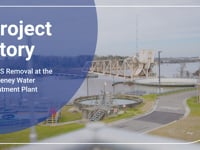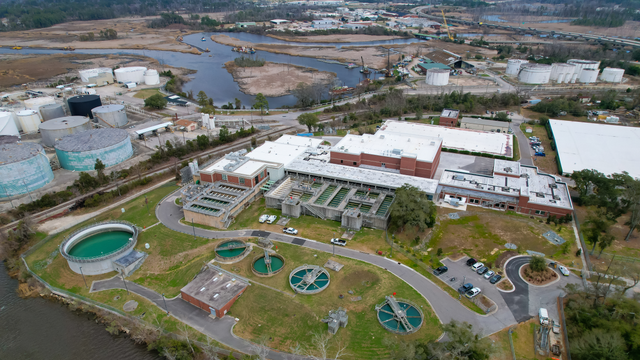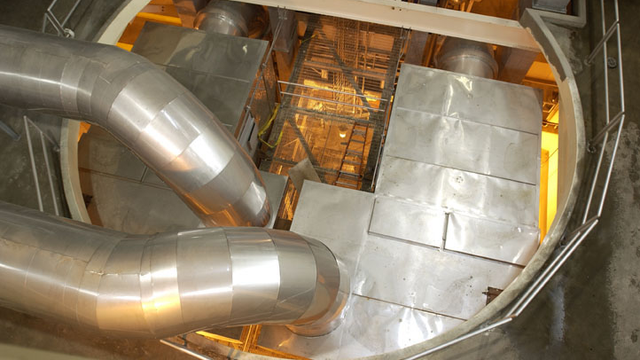With Black & Veatch’s treatment and project delivery expertise, authority acts to resolve contamination in drinking water supply
When per- and polyfluoroalkyl substances (PFAS) including GenX were discovered in its water supply, Cape Fear Public Utility Authority (CFPUA) addressed the contamination decisively with the expertise of Black & Veatch, implementing a new 44 million gallons per day (MGD) granular activated carbon (GAC) contactor facility.
Discovery
CFPUA provides water and wastewater services to homes and businesses throughout the City of Wilmington and most of New Hanover County on the North Carolina coast. The utility currently treats and distributes an average of 19 million gallons of drinking water a day. About 80 percent of it is handled by the state-of-the-art Sweeney Water Treatment Plant (WTP), which uses ozone and ultraviolet technologies for disinfection purposes and has the capacity to treat up to 44 million gallons a day.
The plant’s raw water supply is the Cape Fear River, its intake located about 30 miles upriver from the treatment facility. They are last in line along the river, downstream from communities, agricultural, and industrial enterprises that not only draw from but also discharge into the river’s basin of 6,500 miles of navigable waterways. In other words, the supply for Sweeney is vulnerable to pollution, particularly emerging contaminants such as PFAS.
In 2016, the North Carolina State University published a study that identified PFAS in the Cape Fear River. The discovery sparked intense concern by CFPUA and the public and an investigation by the North Carolina Department of Environmental Quality (NCDEQ). CFPUA began immediately to investigate actions needed to protect public health.
Approach
PFAS are prevalent worldwide. Because their strong chemical bonds are highly resistant to heat, grease, oils and water, PFAS have become a key and valued component of diverse everyday products. They’re also not easily degraded or destroyed in the environment or via conventional treatment processes. As a result, the so-called “forever chemicals” have made their way into our water, air, soil, food, buildings, even our bodies, leading to another issue. PFAS have been associated with a variety of human health issues including low birth weight, high cholesterol, thyroid disease, and an increased risk of certain cancers. It’s why PFAS are under intense scrutiny, from newsrooms, court rooms and board rooms to the halls of government and treatment facilities of utilities.
However, when PFAS were first identified in the Cape Fear River, the body of science on the health effects and acceptable drinking water concentrations of the substances was severely lacking. Adding effective treatment technology to remove PFAS to the satisfaction of all stakeholders without significantly increasing customer rates was a major challenge for CFPUA. Black & Veatch helped CFPUA tackle it.
After conducting initial screening studies, Black & Veatch performed a transparent, multi-phased demonstration testing of advanced treatment technologies to remove the contaminants. The pilot study included on-site real-time testing of both granular activated carbon (GAC) and ion exchange resins. Data from the study was used to develop performance and cost models that helped refine treatment goals and implementation plans. Regular progress meetings and stakeholder workshops were held with CFPUA during the study to ensure established treatment goals were satisfactory and beneficial. Based on the pilot study, CFPUA selected post-filter deep-bed GAC contactors to remove PFAS at the Sweeney WTP.
Design
Black & Veatch has extensive experience in the application and design of granular activated carbon-based water treatment systems for adsorption of contaminants. Over the last 30 years, Black & Veatch has designed over 1 billion gallons per day (GPD) of GAC adsorption system capacity across the United States and worldwide for the removal of PFAS, endocrine disrupting compounds (EDCs), pharmaceutical and personal care products (PPCPs), and other toxic organics.
Black & Veatch’s design for Sweeney provided critical operational flexibility. It enabled CFPUA to operate the contactors in multiple configurations with GAC, ion exchange (IEX), or other proven media resins. The flexibility allows CFPUA to adapt to changing source water conditions and rapidly evolving PFAS regulations.
The design also provided seamless integration with the existing filter complex and pipe gallery, influent pump station and gravity bypass structure, and dedicated truck unloading and media conveyance system to ease impacts of media changeout on plant operations.
In addition, since this was a public health concern, CFPUA was also challenged in implementing the solution as quickly as possible. Black & Veatch worked collaboratively with CFPUA, collectively making design decisions “on-the-fly” as the work progressed, leveraging state of the art design software and BIM solutions. Black & Veatch’s collaborative design approach helped CFPUA establish a proactive and transparent flow of information with all stakeholders.









